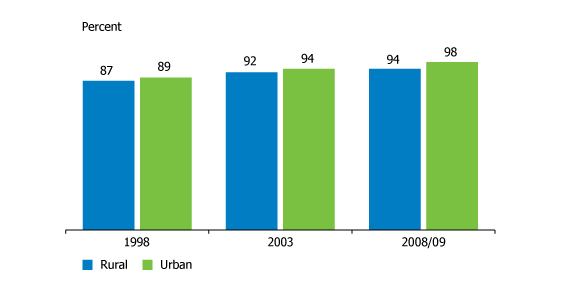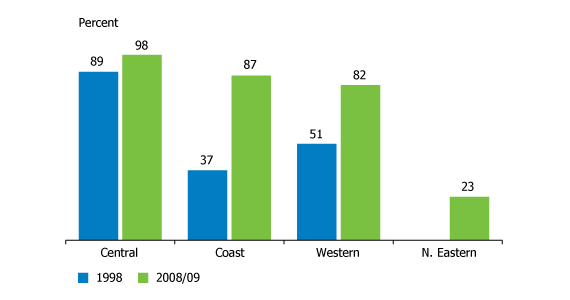
Some Kenyan Children Are Not in School Despite Free Primary Education
Bernard Onyango is a Ph.D. candidate in sociology at Brown University and a trainee at its Population Studies and Training Center (PSTC). He is a participant in PRB’s 2012-2013 Policy Communication Fellows Program, funded by USAID through the IDEA project. This article was written as part of the Fellows Program.
Despite a free primary education policy introduced by the Kenyan government in 2003, a substantial number of children who should benefit from it are still out of school, even though gains have been made between 1998 and 2009.
According to Kenya Demographic and Health Surveys, among children ages 6 to 13, enrollment improved from 87 percent to 94 percent between 1998 and 2009.1 But 6 percent of the nearly 8,000 children sampled were still out of school.
In fact, residence and family income, along with gender, are strong determinants of whether a Kenyan child is in or out of school.2
- Children from rural households are more likely to be out of school than their urban counterparts.
- School enrollment rates differ markedly by province.
- Children from poor families are much more likely to be out of school than children from rich families.
- Nearly as many boys as girls are enrolled in school at the national level, yet pronounced inequalities persist in some provinces.
Although children in this age group are expected to be enrolled in primary school, an undetermined number of the children reported to be in school are actually enrolled at preprimary-school levels. (A strict evaluation based on primary school enrollment would reveal lower school enrollment rates than those reported in this article.)
The Importance of Free Primary Education
Millions of children around the world do not have access to basic education, especially in the developing countries of sub-Saharan Africa and South Asia.3 Millennium Development Goal 2 sets universal primary education as a key target for all nations by 2015. And free primary education was identified as crucial to attaining that goal.
An education is vital for the full realization of an individual’s potential, and is central to a country’s social and economic development.4
In Kenya, Urban Children Have an Advantage
Improvements in school enrollment have been made in both urban and rural locations in Kenya (see Figure 1). While about 11 percent of urban children who were supposed to be enrolled were not in school in 1998, this share declined to about 2 percent by 2008/09. In that same period, the share dropped from 13 percent to 6 percent for children from rural areas.
Figure 1
Urban and Rural School-Enrollment Rates for Kenyan Children Ages 6-13, Selected Years

Sources: Kenya Demographic and Health Surveys, 1998, 2003, and 2008/09.
At both time points, urban children were more likely than rural children to be in school. Of greater concern, however, is that the advantage held by urban children grew from 2 percent to 4 percent, contrary to expectations.
Regional Inequalities
Regional differences in school participation in Kenya have historically been influenced by regional inequality in economic development. Distinct disparities evident today can be traced to decisions made by missionaries and the colonial administration who established formal Western education in Kenya in the first half of the 20th century. Their decisions favored areas of the country where ideal climatic conditions and agricultural potential resulted in a greater concentration of population. This head start has persisted even after Kenya gained independence from Britain in 1963.
For example, by 1990, Central and Western provinces had the highest primary school gross enrollment rates at around 104 percent. Eastern, Rift Valley, and Nyanza provinces followed at 97, 92, and 91 percent respectively. The enrollment rate was about 80 percent in Coast Province, while North Eastern Province was quite low at 24 percent.5 North Eastern Province is the poorest and the least populous province in Kenya. However, the capital of Nairobi Province also had a low enrollment rate at 66 percent. Despite a concentration of population and wealth in the capital, Nairobi is faced with high levels of inequality as a result of a stream of poor rural-urban migrants that has stretched its social amenities, including in the education sector.
In the aftermath of the free primary education policy, enrollments rose in all provinces of the country, but regional inequalities that existed before the policy’s enactment in 2003 were still persistent in 2008/09 (see Figure 2).
Figure 2
School Enrollment Rates for Kenyan Children Age 6, by Region

Sources: Kenya Demographic and Health Surveys, 1998 and 2008/09.
For example, among children age 6 (the age for 1st grade), 98 percent of them were in school in Central Province in 2008/09, 87 percent in Coast Province, and 82 percent in Western Province. North Eastern Province, for which no data were obtained in 1998, lags far behind the rest with a 23 percent enrollment rate for 6-year-olds even in 2008/09.
The Constant Gap Between Rich and Poor
Looking at household wealth, 99 percent of children from the wealthiest 20th percentile were in school, compared with 84 percent of those from the poorest 20th percentile in 2008/09. These figures were 93 percent and 78 percent, respectively, in 1998.
Clearly, while both groups have benefited from free primary education, the gap in enrollment rates between the rich and the poor has not diminished.
Educating Girls
At the time of Kenya’s independence in 1963, many more boys than girls went to school. Social customs and gender roles generally favored boys at the expense of girls. As cultural barriers to girls’ education whittled down with time, these differences in enrollment declined considerably. By 2000, nearly as many boys as girls were enrolled in school, and enrollment rose from 87 percent in 1998 to 94 percent in 2008/09.6
But striking variations in enrollment rates are evident at regional levels. For example, about 99 percent of both girls and boys were likely to be in school in Central Province in 2008/09. On the other hand, girls fared much worse than boys in North Eastern Province, at 56 percent and 64 percent, respectively. A government report links gender differences in school participation in Kenya to traditional and cultural barriers that disadvantage girls.7 These include practices such as early marriage and female genital cutting that affect the older girls in the 6-to-13 age group, and lead to dropping out of school. In a patriarchal society, and in poor households, sons’ education is at times supported at the expense of their sisters’ education, because of a perception that boys will contribute to the future wealth of the family.
Further Research
My ongoing research measures the impact of the free primary education policy on the determinants of school participation. I am interested in finding out whether the policy has intervened favorably on these determinants and therefore reduced inequality in access to school over time. I am also evaluating whether enrolled children are in the expected grade levels given their age, since a late start to primary school and grade repetition are known problems in developing countries.8
References
- National Council for Population and Development, Kenya Central Bureau of Statistics, and Macro International, Kenya Demographic and Health Survey, 1998 (Calverton, MD: Macro International, 1999); and Kenya National Bureau of Statistics and ICF Macro, Kenya Demographic and Health Survey 2008-09 (Calverton, MD: ICF Macro, 2010).
- World Bank, World Development Report 2012: Gender Equality and Development (Washington, DC: World Bank, 2012).
- Emilio Porta et al., Assessing Sector Performance and Inequality in Education: Streamlined Analysis with ADePT Software (Washington, DC: The World Bank, 2011).
- Emily Hannum and Claudia Buchmann, “Global Educational Expansion and Socioeconomic Development: An Assessment of Findings From the Social Sciences”World Development 33, no. 3 (2005): 333-54; and Eric A. Hanushek and Ludger Woessmann,”The Role of Cognitive Skills in Economic Development,” Journal of Economic Literature 46, no. 3 (2008): 607-68.
- Arjun S. Bedi et al., “The Decline in Primary School Enrollment in Kenya,” Journal of African Economies 13, no. 1 (2004): 1-43. The gross enrollment rate is the total enrollment in a specific level of education, regardless of age, expressed as a percentage of the official school-age population for that level of education in a given school year. The rate can be greater than 100 percent.
- Moses Oketch and Caine Rolleston, “Policies on Free Primary and Secondary Education in East Africa: Retrospect and Prospect,” Review of Research in Education 31, no. 1 (2007): 131.
- Ministry of State for Planning, National Development and Vision 2030, Millennium Development Goals Status Report for Kenya, 2009 (Nairobi: Ministry of State for Planning, National Development and Vision 2030, 2010).
- UNESCO, Youth and Skills: Putting Education to Work (Paris: UNESCO, 2012).
